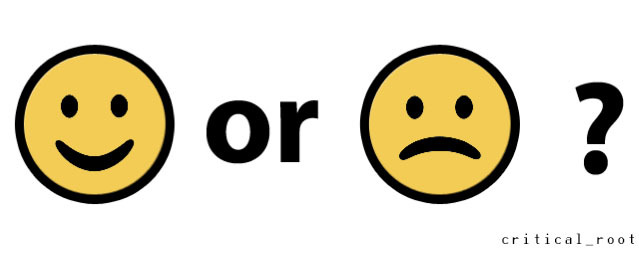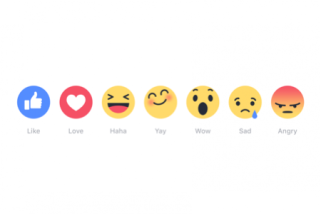
What is Sentiment Analysis?
First, we need to know what sentiment analysis means. According to the Oxford dictionary, sentiment analysis refers to the process of computationally identifying and categorising opinions expressed in a piece of text, especially in order to determine whether the writer’s attitude towards a particular topic, product, etc. is positive, negative, or neutral.
In order words, it is the process we determine the emotional tone behind a series of words and gain an understanding of the writer’s view and attitude behind the limited expression.
The use of Sentiment Analysis
Undoubtedly, sentiment analysis is widely used nowadays. It allows us to gain the opinion of the public over certain topics. We can get the answer very quickly. One of the most common examples is Facebook.
As shown in the above figure, we can immediately react to the topic and show our feelings.
Is sentiment analysis always reliable?
Human language is complex. Sometimes we humans interpret the wrong meaning in both spoken and written language, teaching a machine to interpret the tone behind words is even more difficult.
“Anyone who says they’re getting better than 70% [sentiment accuracy] is lying, generally speaking” ( Source:http://www.theguardian.com/news/datablog/2013/jun/10/social-media-analytics-sentiment-analysis
I guess 50-60% of accuracy won’t be convincing when you are making some important business decisions. The result can be disastrous if we are making decision based on inaccurate sentiment analysis.
So, we should be aware and understand the methods the social media ventor is using. There are many methods and here I would like to discuss two of them.
- Keyword Processing
In this method, words are categorized as ‘positive’ or ‘negative’. Then, it determines the overall percentage of positive or negative words in a passage.


This method is fast and cheap to implement. However, it may not be useful when dealing with double positives or doule negatives.

- Natural Language Processing (NLP)
NLP is another method that makes the computer understand natural language input and generate natural language output. In order words, computers can get the meaning of human words, as it understands that several words form a phrase, several phrases form a sentence, and sentences express ideas.
Though NLP seems reliable, it still has limitations. For example, it cannot interpret sarcasm and acronyms. Consider the sentence: “He has no enemies, but is intensely disliked by his friends.” We can understand “friends” do not mean a true friend here but the computer will not inerpret the same meaning.


Summary
While sentiment analysis becomes more popular nowadays. As an analyst, we should choose a suitable method carefully so that the result can be more comprehensive and reliable. As a user, we should choose a vendor that treats sentiment analysis seriously and is capable to update their technology regularly.
You raised some good points and I agree that Sentiment Analysis is very common nowadays on social media. Often our word choice contributes to atmosphere of a phrase and some ‘strong’ words highlights the overall mood of an opinion. This is particularly important when we are considering sentiment analysis. Sentiment analysis can allow us to understand the overall ‘trend’ of the opinions on a certain issue, which is important to note when we are analysing the contents and drawing conclusions from the opinions. There is still quite a long way to go for sentiment analysis to be at least 90% accurate since there are too much proverbs and negated meanings.
LikeLike
Hi, i would like to provide some supplementary information here. As you mentioned above, there are too much proverbs and negated meanings that makes misunderstanding. I would like to raise an idea that semantic information is actually a role of supplementary information. It helps us to understand the meaning of words and the images or icons should be easy to understand and some physical information should be provided besides it to avoid misunderstanding. There are no such way to express the information that having no disadvantage. We should use multiple ways to express an information to make sure they covers others disadvantages.
LikeLike
When discussing whether sentiment analysis is always reliable or not, I think that the problem is that the more you break down the data, the less likely it is that sentiment analysis will get it right. Sentiment analysis works best with large amounts of data and can’t be relied upon for smaller samples.
However, despite these limitations about the sentiment analysis, it is fast and close to real-time. It is very good at is spotting high-level trends and extreme swings in sentiment such as swearing and complaints which makes it great for social customer services. I think that what we can do with or improve the tool of sentiment analysis is to mixture human analysts and machine analysis together in the current development of sentiment analysis.
LikeLike
You have discussed the topic sentiment analysis and I agree what you have mentioned that the reliability of sentiment analysis is not always high for analyzing. We should never obmit that there are some sentiments or views, which cannot be expressed simply as positive or negative. Many sentiment analysis algorithms are using some simple terms to express them while some complex contexts are so difficult to be translated. Despite this, sentiment analysis does exist its great value of which many applications are making use. For example, by using sentiment analysis, We can,in a fast pace, keep track of public’s reviews, survey responses and etc, thus using in business or other aspect analytics.
LikeLike
Sentiment analysis is indeed a useful tool in this information age. But just as you said, sentiment analysis still has it limitation, which is it may not be always reliable. Apart from your example of double positives/negatives, I also think that the analysis cannot really work well if the comments have some behind meanings, or maybe the people are saying sarcastic or ironic comments. Besides, what if the people spell the wrong word? If they spell “not” to “nto”, without detecting the word “not”, the whole meaning of the comment is reversed.
But overall we still rely on sentiment analysis a lot and we cannot ignore its importance. In the future, this is our job of engineer to tackle those problems in sentiment analysis, how to increase its accuracy, for example, doing some works on big data to make a strong and big enough database for processing sentiment analysis.
LikeLike
Undoubtedly, sentiment analysis is difficult to be performed by machines because there are so many ways to interpret one’s meaning and the machines will make mistake if the interpretation is done wrongly. In order to improve the performance, big data technology can be used. With the help of big data, more language models can be constructed to interpret one’s meaning more accurately. As a result, the machines will be more “smart” to interact with people and give a corresponding respond.
LikeLike
I second your views. You implied that Sentiment Analysis only have 50-60% accuracy. In fact, Sentiment Analysis cannot be applied in to comparison sentences. When we say “Apple is better than Samsung”, which is neither positive or negative. Therefore, the complex linguistics structure is a barrier of applying Sentiment Analysis.
To tackle the low accuracy problem, I have 2 suggestions on it. First, we should focus on the particular field. The depth of understanding can affect the accuracy of Sentiment Analysis. If the topic is specified enough, Sentiment Analysis can have a precise result. Second, using n-gram but do not use Unigram. With more words inside the n-gram, Sentiment Analysis have a lower chance of misunderstanding.
LikeLike
Talking about making business decisions, do you still remember the advertisement of Nestle White Coffee? The marketer of Nestle has made good use of sentiment analysis (Facebook reactions of Leon Lai’s official Facebook fan page) to choose the spokesperson. From the interviews, the marketer has explained that Leon Lai is one of the most influencing Hong Kong idol digitally and he receives the least negative reactions (i.e. sad and angry reactions) every time he updates his fan page. This is an extremely successful example of the use of sentiment analysis that I have heard of so far.
LikeLike